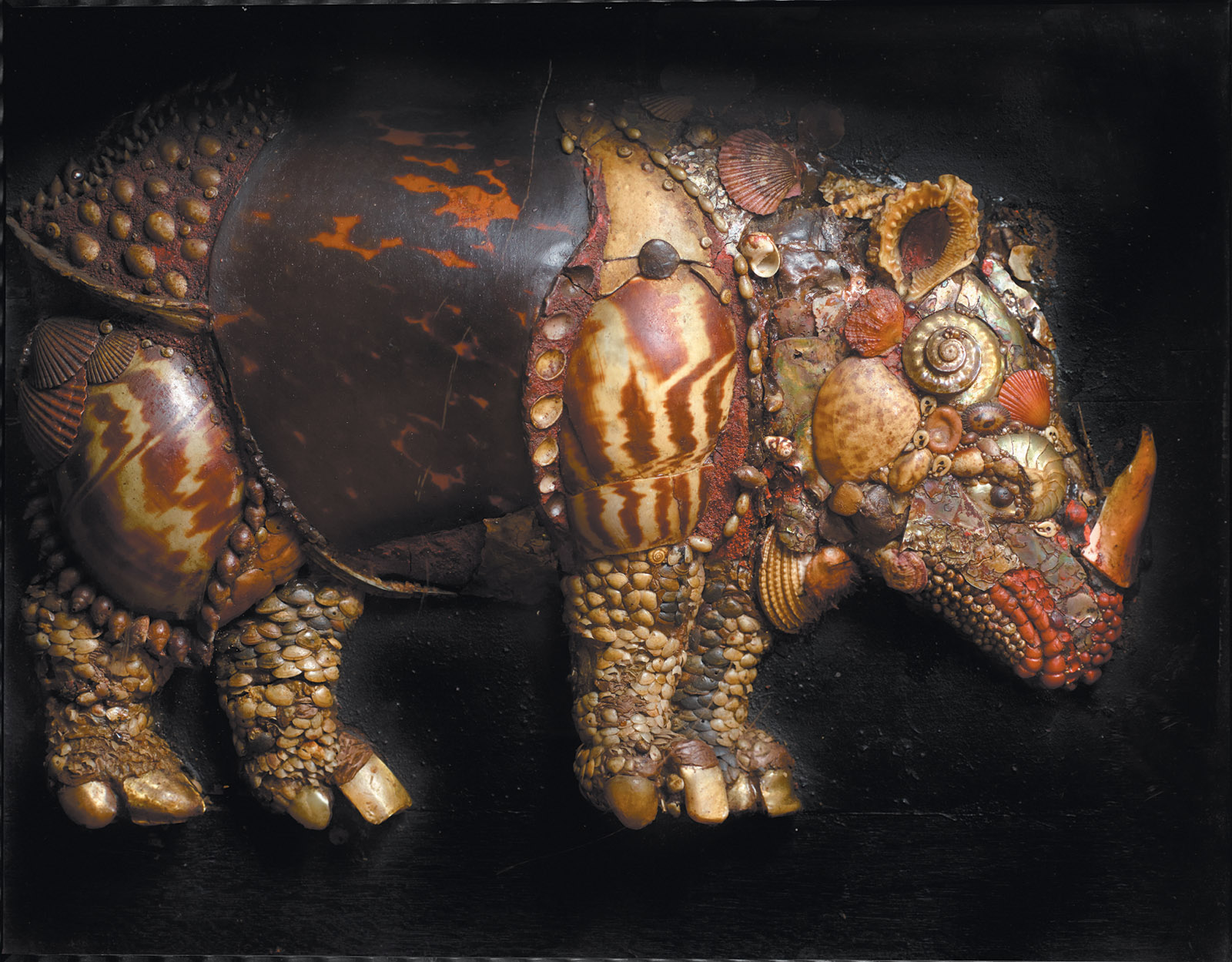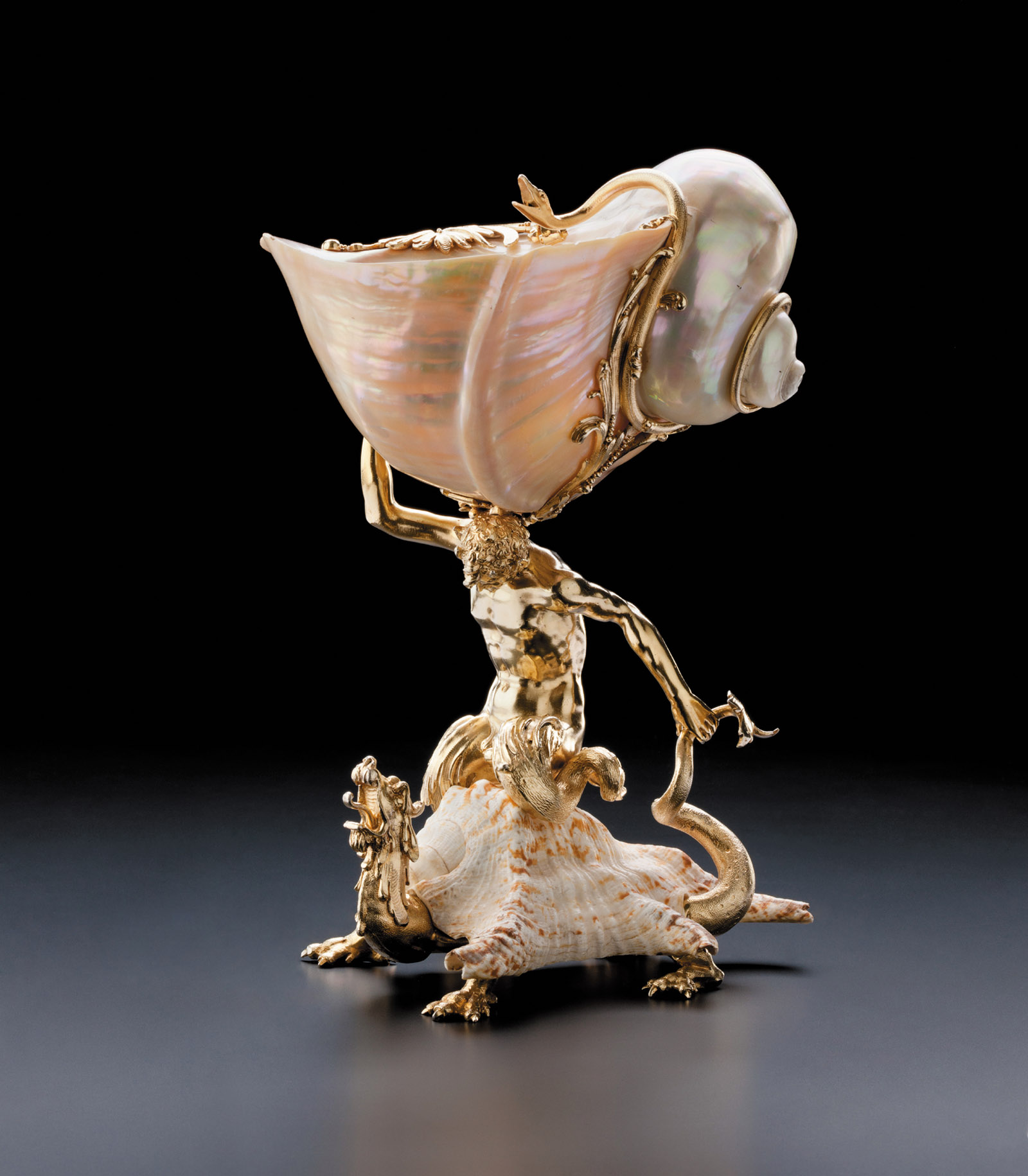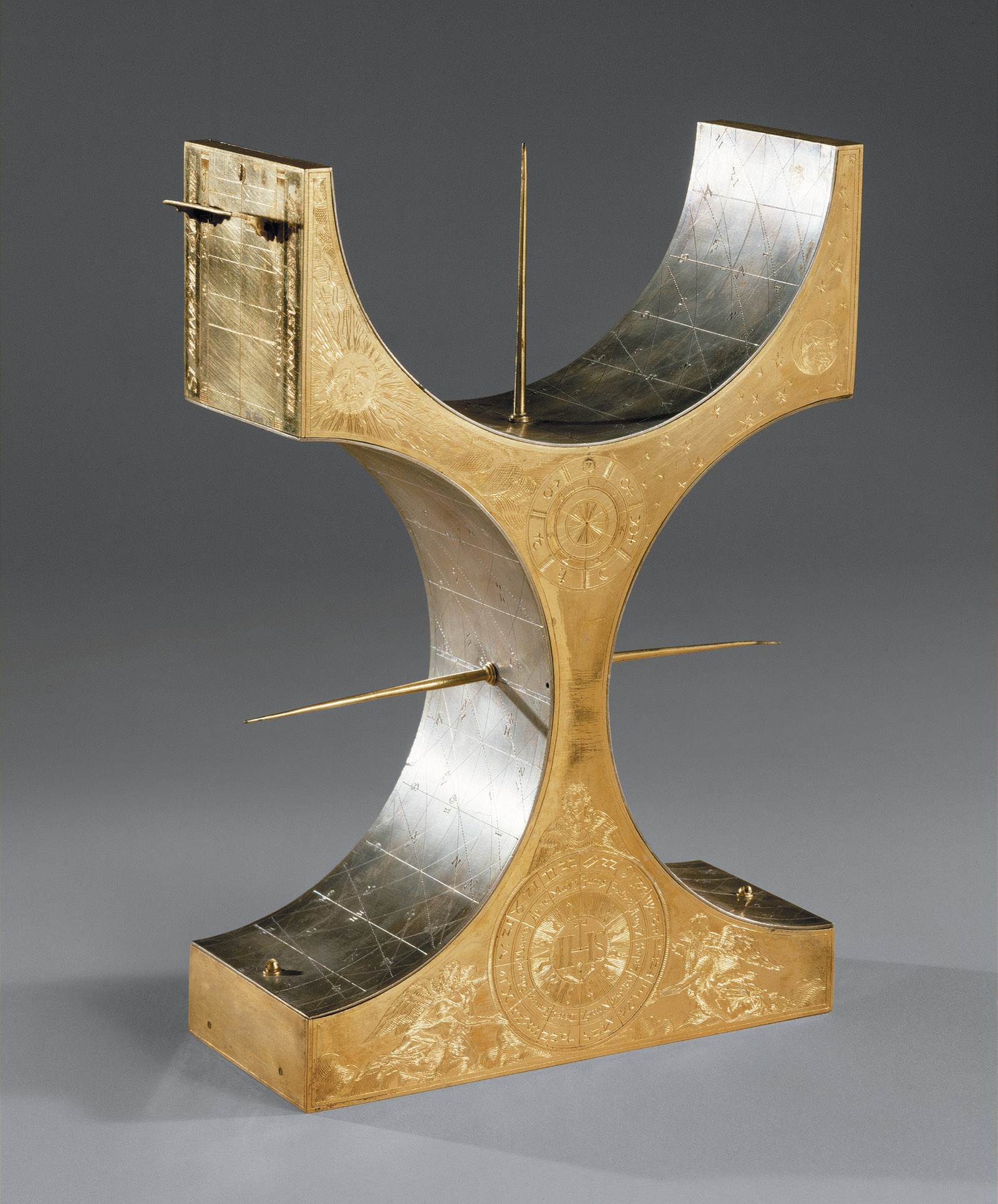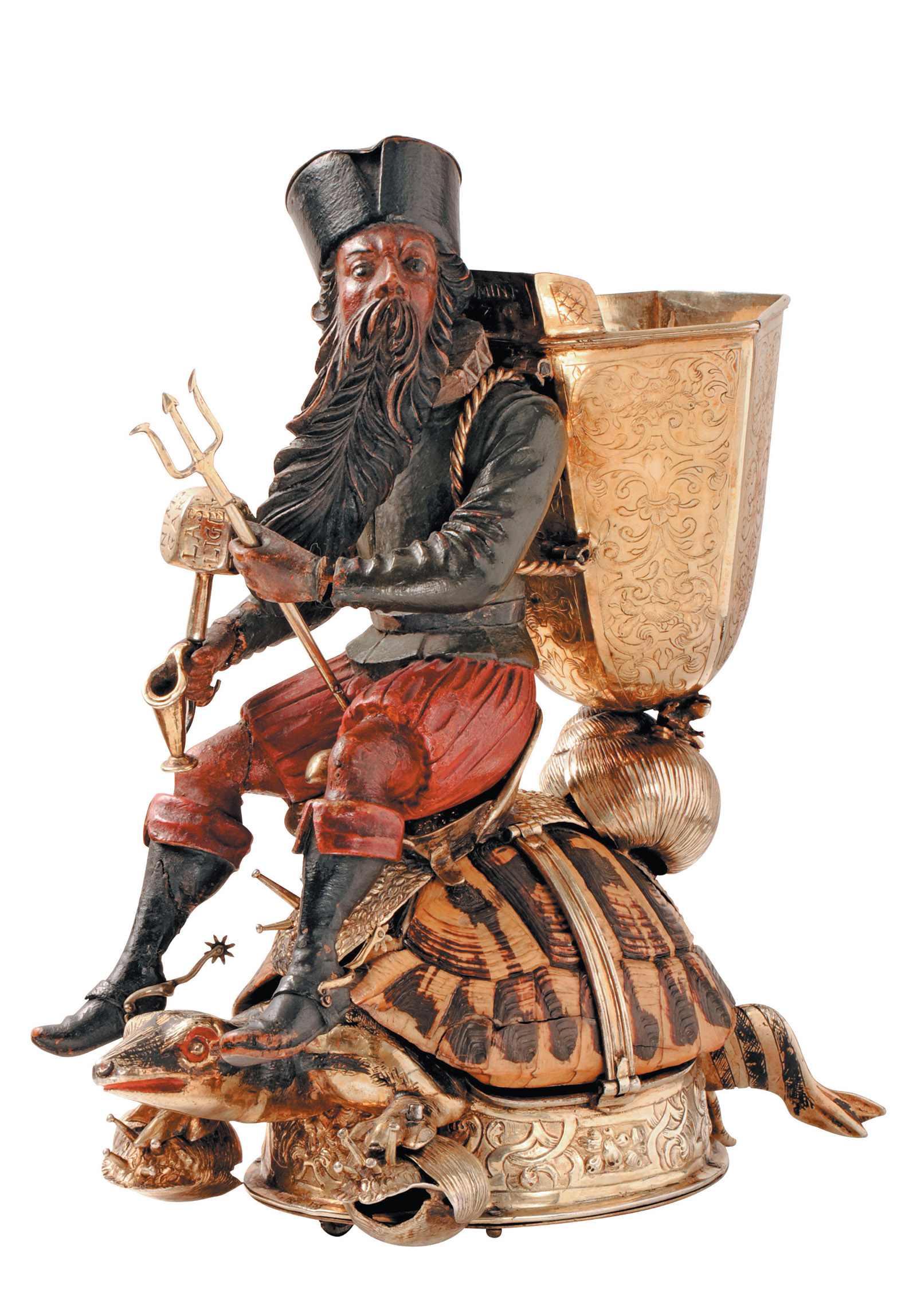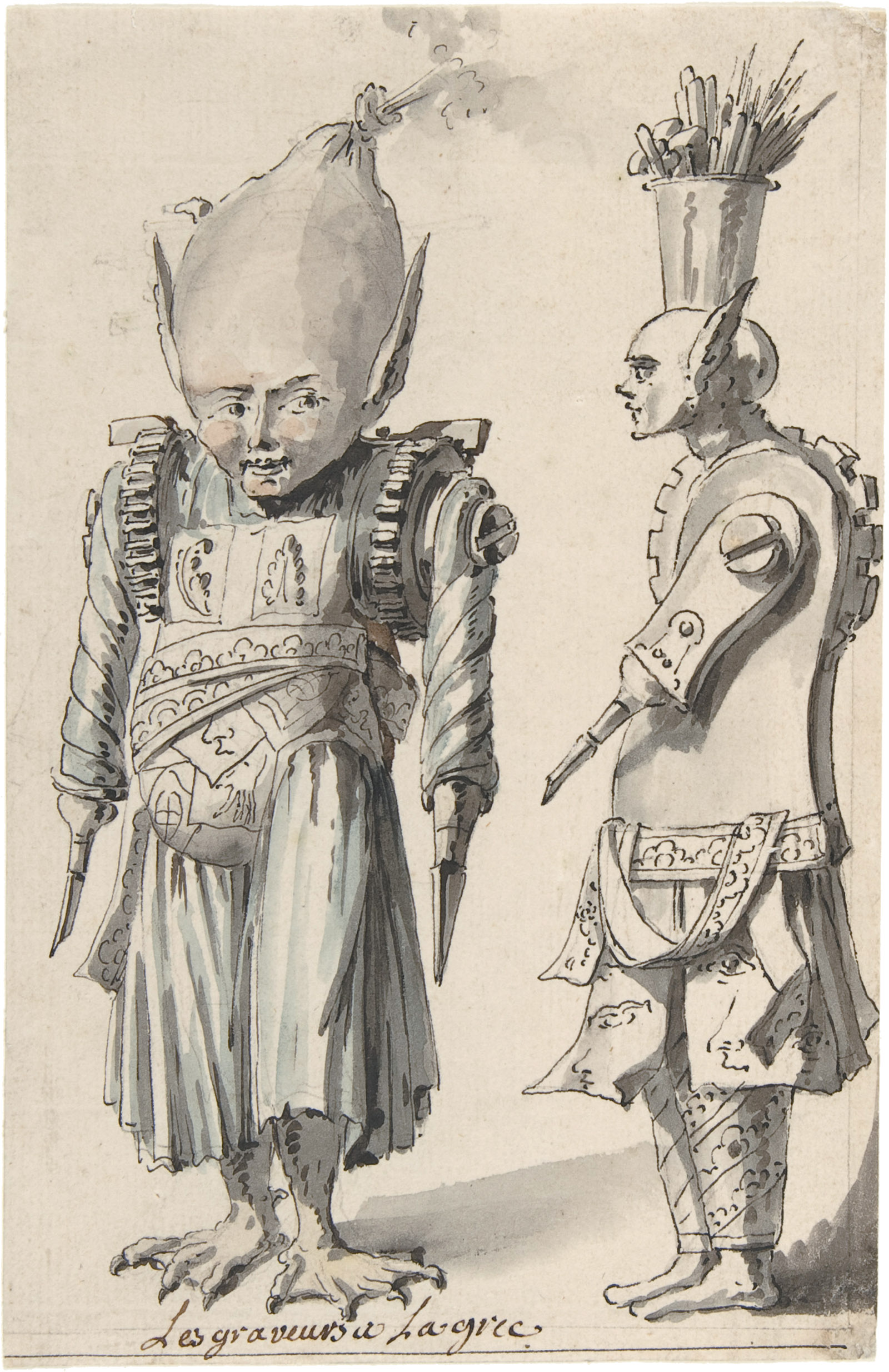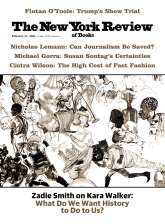In the early sixteenth century, Holy Roman Emperor Maximilian I declared, in one of the semi-autobiographical romances he wrote to promote his accomplishments and the providence of his reign, that rulers should establish their authority over vassals and subjects by gaining “secret knowledge and experience of the world.” His royal successors and emulators “proclaimed their divine right to govern” by collecting “objects and instruments, each more beautiful, ingenious, or wondrous than the next” and by “embracing practices that showcased their skill and erudition,” as Wolfram Koeppe writes in a catalog essay for “Making Marvels,” an exhibition he curated at the Metropolitan Museum of Art. The wide-ranging and eclectic show presents rare, costly, and sometimes bizarre objects from the sixteenth to eighteenth centuries that belonged to aristocratic families throughout Europe and that signaled their access to precious materials, exquisite craftsmanship, and scientific and occult learning.
Early modern royals acquired exotic natural artifacts such as bezoars—digestive stones produced in the intestines of large ruminants and believed to possess healing qualities. They commissioned lavish clocks encased in silver; they purified metals in alchemical laboratories; they studied, and sometimes made important contributions to, astronomy. Princes were taught crafts such as turning ivory on a lathe, which was thought to improve one’s ability to govern because it required precision, concentration, and a steady hand. “Making Marvels” includes a dozen intricate and whimsical ivory pieces made by royalty and their instructors; with wobbly, stacked forms, nested polyhedral shapes, and improbable shifts, they look more like something out of a Dalí desert scene than a sixteenth-century court.
Three of these pieces are the handiwork of the Saxon elector Augustus I (1526–1586), the son of Henry IV the Pious, who established Lutheranism as his dukedom’s religion. Augustus serves as the exhibition’s guiding spirit. He was firmly rooted in medieval aristocratic traditions but was also committed to the humanistic and scientific spirit of his century. For instance, though he participated in fifty-five “jousts of war,” in which combatants used sharp lances, he eventually replaced jousting with less dangerous equestrian competitions. The size of Saxony’s armory grew tenfold during his reign, but he also amassed tools and manuals relating to every type of trade.
Called “Father Augustus” by his subjects, he sought to strengthen his realm not through conquest but through economic development. He introduced agricultural reforms and conducted extensive surveys of his lands to better exploit their deposits of silver, iron, serpentine, and alabaster. (An early odometer in the exhibition was used to record distances during these surveys.) Augustus also oversaw improvements in Saxony’s mining industry; De Re Metallica, widely considered the first scientific treatise on mining, was written by Augustus’s “most learned, dear and faithful subject” Georgius Agricola. (Despite his esteem, Augustus initially denied the Catholic Agricola a Christian burial.)1
The mining, refining, and casting of silver runs through “Making Marvels” like a rich vein of ore through a mountain. “As silver was itself a form of currency,” Koeppe writes, “there was no more direct expression of one’s wealth than ownership of silver objects.” If a royal family was ever in need of cash, it could simply melt down the silver utensils and ornaments it had acquired in more prosperous times. The importance of mining—of silver as well as other materials—to royal power was such that princes sometimes dressed up as miners at banquets.2
“Making Marvels” displays Augustus’s alchemical furnace, in which he would heat metals to determine their composition. Alchemy had many practical uses, such as the production of dyes and pigments, but the manipulation of gold and silver was its most alluring application. Alchemists could separate out metals from alloys and devise alloys of precious metals that looked like the real thing. Many rulers—including the Habsburgs and the Medici—practiced alchemy themselves and appointed court alchemists to assist their treasuries, and perhaps to enrich them through the elusive process of transmuting base metals into gold, known as chrysopoeia.
A reputation for alchemical skill sometimes brought practitioners not money but misery. When the Saxon elector Augustus the Strong (the great-great-great-grandson of Augustus I) heard in 1701 of Johann Friedrich Böttger’s successful transmutations, he arrested Böttger and ordered him to make gold. Böttger never fulfilled Augustus’s demand, but he did figure out how to make porcelain, a Chinese technology that had eluded Europeans for hundreds of years. The lucrative porcelain factory at Meissen, which has operated from 1710 to the present day, could not have been established without this discovery. Böttger was never released, and he died Augustus the Strong’s captive.
Augustus I is believed to have established one of the first Kunstkammern—repositories of “secret knowledge of the world.” Kunstkammern housed “only the most exceptional artifacts, natural and man-made,” as Paulus Rainer, a curator at Vienna’s Kunsthistorisches Museum, writes in his catalog essay. The objects included in these extensive curiosity cabinets testified to a ruler’s erudition, wealth, and taste, combining beautiful and expensive stone- and metalwork with rare goods from lands only recently reached by Europeans. A Kunstkammer might contain preserved specimens of exotic animals like armadillos or alligators, natural artifacts fashioned into decorative cups or ewers, artworks from the New World or the Far East, portraits (and occasionally live examples) of deformed humans, and novelties such as playing cards meant for use by giants and dwarfs.
Advertisement
Augustus’s Kunstkammer was a private place to which he retreated to practice crafts like cabinetmaking and locksmithing, and to consult maps of his domain, but most Kunstkammern were, as Dirk Syndram, the director of the Green Vault museum in Dresden, says, “an elitist, magical instrument” that broadcast a sovereign’s divine license and worldly power. Many collections served diplomatic purposes, conveying a prince’s economic and political connections to visiting ambassadors and royalty. Local scholars, artisans, and artists would also have been able to consult their patrons’ holdings. A few Kunstkammern were even open to the public; the admission fee, however, was usually a contribution to the collection, suggesting that only those with great wealth, knowledge, or skill could gain entry.
Kunstkammern are frequently described as microcosms, containing in themselves everything one could know about the universe. But as Rainer notes, any collector who wished to encompass the whole world “was doomed to fail.” The goal was not comprehensiveness, he argues, but an assemblage of things that would provide “an understanding of what is normal…by way of the abnormal”—exceptions that proved the rule. He quotes the Holy Roman Emperor Maximilian II’s instruction to an ambassador he tasked with finding objects for his Kunstkammer: “The more unusual, the better.”
A Kunstkammer was, Rainer writes, “a place of learning” and “an instrument of astonishment, a laboratory for thought that could provoke creative responses to questions from many realms of life.” The desire to show off splendid items in a splendid and novel way led to some unexpected transformations. “Making Marvels” contains a reimagining of Dürer’s famous print of a rhinoceros composed out of shells, coral, and pearls. A piece described as a “grotesque wild boar” has a body made out of a coconut, along with a gilded-silver head, arms, legs, tail, and a pair of wings. An ostrich egg forms the body of an ostrich-shaped silver ewer; its head, incongruously, looks more like that of a camel than of a large flightless bird, perhaps the result of an educated guess by a craftsman who knew that the two-toed ostrich was sometimes said to have “camel feet” (Linnaeus later named ostriches Struthio camelus).
The delicate opalescent shells of turban snails and nautiluses—large mollusks found in the Indo-Pacific Ocean—were common in Kunstkammern and carried a baffling array of symbolic meanings: they were aphrodisiacs that also represented chastity (because pearls, like the Virgin, are seemingly created from nothing), examples of natural perfection that also reminded man of his mortality (because the snail is imprisoned in its shell as the soul is in a body). For display in Kunstkammern, shells were made into cups bearing mythological or maritime iconography inspired by their origins. The stem of one turban-shell cup in “Making Marvels” is a gilded-silver Triton astride a dragon, its body covered with a spider conch shell (see illustration). Koeppe suggests that this Triton “perfectly embodies” the theme of “humanity’s enslavement to burdens and worldly goods”: he carries the weight of the cup on his shoulders but must also control the beast beneath him.
Craftsmen in Asia and the New World created works especially for well-to-do Europeans, who considered these products “the ultimate luxury items from a faraway world that most…would never get a chance to visit.” A feather mosaic, made by Mexican artisans in the late sixteenth century, depicts Saint Michael slaying the devil. Though the mosaic appears matte in its vitrine, spectators can view it illuminated in a mirror below, revealing the archangel in resplendent iridescence—a sheen more impressive than any of the metallic or nacreous surfaces in the exhibition.
Scientific instruments and other technology were highly prized Kunstkammer objects, expressing a ruler’s mastery over an organized, rational universe. Time-telling devices conveyed this notion most clearly and formed a crucial part of the Kunstkammer program—“Making Marvels” contains dozens of examples, including both elaborate sundials (one in the exhibition could be used as far north as Gdańsk and as far south as Corfu)and even more elaborate clocks.
Advertisement
Before the late sixteenth century, clocks had been powered by water pressure or by weights and were often monumental in size. The introduction of steel springs allowed them to be “miniaturized” to a mere two feet tall. But these spring-powered clocks ticked unevenly and, as a result, were inaccurate. (An early-seventeenth-century pocket watch in the Met’s permanent collection, but not shown here, even contained a sundial on the inside of its lid with which to regulate the mechanism, since the former was more dependable.) It wasn’t until the late seventeenth century, when the mathematician Christiaan Huygens developed the pendulum clock and, later, the spiral balance spring, that clocks became reliable timekeepers.
Yet early modern clocks did much more than tell the hour: they also tracked the days of the week, the paths of the sun and the planets through the zodiac, and the phases of the moon. The Imser Clock, which greets visitors upon entering “Making Marvels,” takes the shape of a silver tower topped by a cupola, and its dials show the positions of the sun and planets, the lunar cycle, and saints’ days. Time is told by a female figure who moves around the top of the tower, her hand pointing to the minutes, which are inscribed on the parapet; every fifteen minutes she turns a corner, passing a door in the cupola that opens to reveal a male figure representing the passage of time: a boy, a young man, a bearded man, and, at forty-five minutes past the hour, a skeleton. Even the masters of the universe had to be reminded of their mortality.
Automata, or moving mechanical figures, were often included in clocks because both were constructed using similar technologies. This combination goes back to antiquity, with the clepsydrae, or water clocks, of the engineer Ctesibius; a medieval Islamic source even claimed that Archimedes built a clepsydra featuring a bird that ejected balls from its beak to mark time. In 807 the Baghdad caliph Harun al-Rashid gave Charlemagne a clock that dropped an appropriate number of brass bells into a basin at the start of each hour; at noon twelve horsemen sallied forth. Some automaton conceits proved especially resilient: “Making Marvels” contains a late-eighteenth-century Flemish clock in the shape of an obelisk with four dragons at its base that spit pearls. (Unfortunately, the Met is not running any of the automata in the show, though videos of some of them are projected in the galleries and can be viewed on the museum’s website.)
There was always a bit of the divine, or demonic, about automata. A mechanical monk shown here is believed to have been commissioned by King Philip II of Spain to commemorate a Franciscan lay brother, Diego de Alcalá, whose spirit supposedly healed Philip’s son Don Carlos of an infected head wound in 1562. (Diego later became the namesake of San Diego, California.) The figure nods its head and moves its mouth in prayer as it rolls forward, turning at a right angle every two feet to complete a square circuit.
Many Catholics believed automata were crucial to diplomatic and missionary efforts. Jesuits hoping to impress the Chinese emperor with Western scientific and technical knowledge sent automata clocks to the Forbidden City. Although the missionaries themselves were initially denied entry, they were soon fetched when the clocks needed to be wound up again. In the late sixteenth century Habsburg rulers, as part of their annual tribute to the Ottoman Empire, sent large silver clocks and automata from Augsburg to Istanbul, accompanied by clockmakers in case repairs were needed. The sultans and viziers seem to have enjoyed the machines less than the Chinese: a European visitor reported that “the beautiful clockwork that the sultan has received over the years are piled in a chamber; they are destroyed by rust and some are sold off.”3
In areas that left the Catholic Church during the Reformation, automata came to be seen as fraudulent—like the eucharist, an automaton was matter pretending to contain spirit. Henry VIII, for example, banned all mechanical statues from Anglican churches. Nevertheless, some Protestant rulers, including the electors of Saxony, bought automata for private amusement: one shown in the exhibition, which likely belonged to a daughter-in-law of Augustus I, is in the form of a crayfish; another, only one inch long, a golden spider.
Automata were also used in drinking games, a cherished aristocratic pastime. A gilded woman playing a cittern (similar to a lute) on display here would move around a banquet table; when she stopped, the person closest to her was obliged to imbibe. Other machines in “Making Marvels” that served similar purposes have mythological designs. Neptune sits on a turtle and carries on his back a silver cup that would have been filled before he was set in motion. Most beguilingly, a still-functional automaton of Diana, holding a bow and arrow and riding a moving chariot, casts her eyes left and right as if she were choosing her next victim. When the chariot stops, she shoots an arrow; its landing place determined who drank next.
The age of the Kunstkammer ended in the seventeenth century. Many royal collections were plundered during the Thirty Years’ War, some were sold off or transferred to treasuries, and others were eclipsed by early museums and royal collections like Augustus the Strong’s Green Vault, which was open to the public.4 The seventeenth- and eighteenth-century clocks in the final rooms of “Making Marvels”—such as the two spherical clocks held aloft by a wall mount in the shape of a human arm—were likely integrated into palace décor rather than secluded in a separate space. The astonishing eighteenth-century automata included in the show, however, served similar purposes as their predecessors: they reflected rulers’ access to advanced technology and were constructed to amuse and confound guests.
The Miraculous Writing Machine was given to Empress Maria Theresa in 1760 by Friedrich von Knaus, a clockmaker in her employ. The machine, which was never presented to the public, features a small statue of a woman holding a quill. She sits on a globe containing a cylinder dotted with holes in which pegs can be placed, with each peg corresponding to a letter. The automaton can be programmed to write up to 107 words. A video playing in the Met’s gallery shows her writing “Technisches Museum Wien,” her current home.
The mechanism Knaus used is based on the work of the French inventor Jacques de Vaucanson, who in the 1730s exhibited three machines, none of which survives, that became the most celebrated automata of the eighteenth century: a flute-playing faun, with a flexible tongue and leather-padded fingers to reduce clacking, that had a repertoire of twelve songs; a shepherd that played dance tunes on a fife and drum for twenty minutes; and a duck that swallowed grain and, after apparently digesting it, defecated. (In fact, the grain was deposited in one receptacle and the feces stored in another.) Voltaire called Vaucanson “Prometheus’s rival,” and Diderot considered him the foremost example of a great man. Vaucanson’s later career was less illustrious: for the rest of his life he was consumed by a failed project to build an automaton out of rubber that would perfectly imitate “all animal operations,” including circulation of the blood, muscle movement, and, of course, digestion.
With the notable exception of Vaucanson, makers of Enlightenment automata intended to entertain audiences, not to investigate philosophical questions relating to the nature of consciousness or the mechanical reproduction of biological functions. Nevertheless, concerns about technological displacement were already being expressed in the late eighteenth century. A fanciful drawing by Jean Charles Delafosse that is hung nearby the Miraculous Writing Machine depicts two androids whose bodies incorporate tools used for engraving, threatening the livelihood of printmakers. Delafosse’s (perhaps playful) anxiety was shared by the German writer Jean Paul, who wrote a number of short satires about automata in the 1780s, including one in which he discusses the likelihood of machines performing the tasks of civil servants, judges, churchgoers, and even writers.5
Though Delafosse and Jean Paul could not have foreseen it, there was good reason to worry. Vaucanson used the mechanism he had invented for his automata to construct a predecessor to the Jacquard loom, which in turn inspired Charles Babbage’s Analytical Engine, itself a predecessor to the modern computer.
The last room in “Making Marvels” contains a reproduction, completed in 2005, of the chess-playing automaton known as “the Turk.” First built by Wolfgang von Kempelen in 1769 for Empress Maria Theresa and reassembled a dozen years later at the request of Joseph II, the Turk ended its career in 1854 in the United States, making it an unlikely bridge from the royal amusements so delightfully displayed in “Making Marvels” to the mass entertainments of the nineteenth century.
The Turk’s nickname comes from its design: a wooden man in a turban and fur-trimmed red coat sits behind a large cabinet on which a chessboard is placed. The contraption appeared to be the most complicated automaton ever created. It was capable of playing complete games of chess against humans; more impressively, it won almost every match it played and even corrected moves by opponents when they made mistakes or cheated. The automaton’s attire may have had, as the writer Gaby Wood suggested, “the psychological effect on audiences of a particular Orientalist fantasy: the unknown, the spirit-like forces of darkness, came dressed in the attire of the East.”6
Von Kempelen toured the Turk through courts and cities in Europe, where it played, and beat, illustrious opponents like Ben Franklin and Catherine the Great. Before each match began, von Kempelen opened the cabinet to reveal a set of gears and a chamber with wires and rods, showing that there was nobody inside secretly operating the machine; he then turned a large key to “wind up” the contraption.
As early as 1784, Philip Thicknesse, a British writer whose biographer called him “the most quarrelsome man who ever lived,” wrote that a chess-playing machine was “UTTERLY IMPOSSIBLE.” He guessed that the Turk was actually controlled from within by a ten-to-fourteen-year-old child, who hid when von Kempelen opened the cabinet and followed the match by looking through the fur trim of the Turk’s coat. Thicknesse wasn’t very far off the mark. He had rightly assumed that there was a person inside the cabinet hiding during the pre-game demonstration, but that person wasn’t necessarily of small stature: at least three of the elite chess players recruited to be the Turk’s “director” were over six feet tall. The gears and von Kempelen’s winding were mere diversions. Magnets hidden in the pieces and beneath the chessboard indicated an opponent’s moves to the director, who tracked the game by candlelight using a miniature board while manipulating the Turk’s arms and hands with levers.
Despite Thicknesse’s protestations, von Kempelen had never claimed the Turk was an automaton; he referred to it instead as an “illusion” or “bagatelle.” But the public found it hard to believe that the Turk was any less remarkable than it appeared. After von Kempelen’s death, it was sold to Johann Nepomuk Maelzel, who traveled with it in America during the 1820s and 1830s. A Baltimore newspaper once reported that two boys watching a performance through a window had seen a man climb out of the Turk’s cabinet; so many people came to confirm the report that a Washington paper accused Maelzel of concocting the Baltimore story as a publicity stunt.
When Maelzel died, the automaton ended up at a subscription museum in Philadelphia owned by Charles Wilson Peale. Before a fire destroyed Peale’s collection, he had been gradually selling off items to P.T. Barnum, who may have eventually acquired the Turk—like so many other objects, it too could have completed the circuitous journey from the palaces of Europe to the mansions of nineteenth-century American moguls. Barnum had met Maelzel in the 1830s and learned from the older man how to attract audiences through manipulation of the press. After Maelzel’s Baltimore incident, Barnum wrote an anonymous letter to a newspaper claiming that Joice Heth, the octogenarian slave he claimed was 161 years old (and whom he brutally mistreated), was actually a “curiously constructed automaton, made up of whalebone, India-rubber, and numberless springs.” The ploy worked, attracting bigger crowds than ever. An impressed Maelzel told Barnum that he would be a hit.
-
1
The only available English translation of De Re Metallica is by Herbert Hoover and his wife, Lou Henry; President Hoover began his career as a mining engineer. ↩
-
2
In a play celebrating Saxony’s rich mineral deposits, Augustus dressed as the god Mercury, whose namesake was used to dissolve metals (and significantly shortened the lives of craftsmen exposed to its noxious fumes). He also once dressed as a peasant during a harvest festival. ↩
-
3
See Jessica Keating, Animating Empire: Automata, the Holy Roman Empire, and the Early Modern World (Penn State University Press, 2018). ↩
-
4
The Green Vault was the victim of a E1 billion heist in November; the Dresden Green Diamond, one of the Green Vault’s prized possessions (and surely one of the most expensive hat ornaments ever made), had been sent to the Met before the heist and is on view in “Making Marvels.” ↩
-
5
See Adelheid Voskuhl, Androids in the Enlightenment: Mechanics, Artisans, and Cultures of the Self (University of Chicago Press, 2013). About two hundred years later, at the height of American paranoia about the ascendancy of Japanese manufacturing, Donald Barthelme wrote a story in which book reviewers in the US are replaced with machines such as the Nakamichi Model 500, which is “capable of deconstructing a book of average length in seven seconds, with 0.5 percent distortion.” The narrator later notes that the “use of industrial robots in book-review assembly was not in itself considered innovative; The New York Review of Books had been using robots, usually British, for years.” ↩
-
6
Gaby Wood, Edison’s Eve: A Magical History of the Quest for Mechanical Life (Knopf, 2002), chapter 2. ↩


